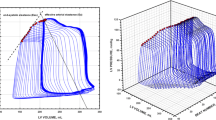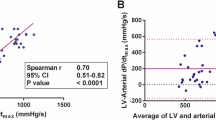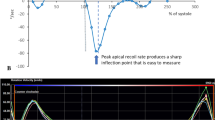Abstract
The maximum rate of left ventricular pressure rise (LV dp/dt max) is a good indicator of ventricular contractility. However, its measurement requires invasive cardiac catheterization. By applying the relationship between the ratio of aorta (Ao) dp/dt max to LV dp/dt max and the mean artery pressure (MAP), we tested the possible noninvasive estimation of LV dp/dt max by the maximum rate of pressure rise in peripheral arteries, as measured by tonometry. The study subjects were 31 children with cardiovascular disease. The LV and Ao pressures were measured during cardiac catheterization, with simultaneous recording of the brachial (BrA) or radial (RaA) artery pressure. The relationships between BrA dp/dt max and Ao dp/dt max and between RaA dp/dt max and Ao dp/dt max were determined (Ao dp/dt max = 0.299 × BrA dp/dt max + 210.6, n = 17, r = 0.78, SEE = 74.0, P = 0.0002, and Ao dp/dt max = 1.442 × RaA dp/dt max + 165.9, n = 14, r = 0.87, SEE = 66.1, P = 0.0001). Using these relationships and the equation Ao dp/dt max/LV dp/dt max = 0.694 − 4.00 × 10−3 × MAP, LV dp/dt max was estimated from BrA dp/dt max or RaA dp/dt max. The estimated LV dp/dt max correlated well with the measured LV dp/dt max independent of the site of measurement (y = 0.912 × x + 112.9, r = 0.91, P < 0.0001). Furthermore, there was excellent correlation between the measured and estimated LV dp/dt max after changes in contractility with dobutamine in 10 randomly selected patients (y = 0.86 × x + 34.2, r = 0.77, P = 0.01). It is possible to estimate LV dp/dt max noninvasively in children using tonometry. This procedure can be useful for bedside assessment of LV contractility and the clinical management of patients with cardiovascular disease.





Similar content being viewed by others
References
Little WC (1985) The left ventricular dP/dtmax-end-diastolic volume relation in closed-chest dogs. Circ Res 56:808–815
Khono K, Tamai A, Kobayashi T, Senzaki H (2011) Effects of stent implantation for peripheral pulmonary artery stenosis on pulmonary vascular hemodynamics and right ventricular function in a patient with repaired tetralogy of Fallot. Heart Vessels. doi: 10.1007/s00380-011-0131-7
Rhodes J, Udelson JE, Marx GR, Schmid CH, Konstam MA, Hijazi ZM, Bova SA, Fulton DR (1993) A new noninvasive method for the estimation of peak dP/dt. Circulation 88:2693–2699
Masutani S, Iwamoto Y, Ishido H, Senzaki H (2009) Relationship of maximum rate of pressure rise between aorta and left ventricle in pediatric patients. Implication for ventricular–vascular interaction with the potential for noninvasive determination of left ventricular contractility. Circ J 73:1698–1704
Laszlo A, Pinter A, Horvath T, Kadar K, Temesvari A, Kollai M, Studinger P (2010) Impaired carotid artery elastic function in patients with tetralogy of Fallot. Heart Vessels. doi: 10.1007/s00380-010-0095-z
Senzaki H, Chen CH, Masutani S, Taketazu M, Kobayashi J, Kobayashi T, Sasaki N, Asano H, Kyo S, Yokote Y (2001) Assessment of cardiovascular dynamics by pressure–area relations in pediatric patients with congenital heart disease. J Thorac Cardiovasc Surg 122:535–547
Taylor S, Snow H, Linden R (1972) Relationship between left ventricular and aortic dP-dt (max). Proc R Soc Med 65:550–552
Sharman JE, Qasem AM, Hanekom L, Gill DS, Lim R, Marwick TH (2007) Radial pressure waveform dP/dt max is a poor indicator of left ventricular systolic function. Eur J Clin Invest 37:276–281
Chen CH, Nevo E, Fetics B, Pak PH, Yin FC, Maughan WL, Kass DA (1997) Estimation of central aortic pressure waveform by mathematical transformation of radial tonometry pressure. Validation of generalized transfer function. Circulation 95:1827–1836
Westerhof BE, Guelen I, Stok WJ, Lasance HA, Ascoop CA, Wesseling KH, Westerhof N, Bos WJ, Stergiopulos N, Spaan JA (2008) Individualization of transfer function in estimation of central aortic pressure from the peripheral pulse is not required in patients at rest. J Appl Physiol 105:1858–1863
O’Rourke MF (1970) Influence of ventricular ejection on the relationship between central aortic and brachial pressure pulse in man. Cardiovasc Res 4:291–300
Karamanoglu M, Gallagher DE, Avolio AP, O’Rourke MF (1995) Pressure wave propagation in a multibranched model of the human upper limb. Am J Physiol 269:H1363–H1369
Khan AH, Spodick DH (1972) The first derivative of the carotid displacement pulse. Am Heart J 84:470–477
Bargiggia GS, Bertucci C, Recusani F, Raisaro A, de Servi S, Valdes-Cruz LM, Sahn DJ, Tronconi L (1989) A new method for estimating left ventricular dP/dt by continuous wave Doppler-echocardiography. Validation studies at cardiac catheterization. Circulation 80:1287–1292
Chen C, Rodriguez L, Guerrero JL, Marshall S, Levine RA, Weyman AE, Thomas JD (1991) Noninvasive estimation of the instantaneous first derivative of left ventricular pressure using continuous-wave Doppler echocardiography. Circulation 83:2101–2110
Chung N, Nishimura RA, Holmes DR Jr, Tajik AJ (1992) Measurement of left ventricular dp/dt by simultaneous Doppler echocardiography and cardiac catheterization. J Am Soc Echocardiogr 5:147–152
Lyseggen E, Rabben SI, Skulstad H, Urheim S, Risoe C, Smiseth OA (2005) Myocardial acceleration during isovolumic contraction: relationship to contractility. Circulation 111:1362–1369
Senzaki H, Chen H, Kass D (1996) Single-beat estimation of end-systolic pressure–volume relation in humans a new method with the potential for noninvasive application. Circulation 94:2497–2506
Marchais SJ, Guerin AP, Pannier BM, Levy BI, Safar ME, London GM (1993) Wave reflections and cardiac hypertrophy in chronic uremia. Influence of body size. Hypertension 22:876–883
Senzaki H, Akagi M, Hishi T, Ishizawa A, Yanagisawa M, Masutani S, Kobayashi T, Awa S (2002) Age-associated changes in arterial elastic properties in children. Eur J Pediatr 161:547–551
Senzaki H, Iwamoto Y, Ishido H, Matsunaga T, Taketazu M, Kobayashi T, Asano H, Katogi T, Kyo S (2008) Arterial haemodynamics in patients after repair of tetralogy of Fallot: influence on left ventricular after load and aortic dilatation. Heart 94:70–74
Trojnarska O, Mizia-Stec K, Gabriel M, Szczepaniak-Chichel L, Katarzynska-Szymanska A, Grajek S, Tykarski A, Gasior Z, Kramer L (2010) Parameters of arterial function and structure in adult patients after coarctation repair. Heart Vessels. doi: 10.1007/s00380-010-0063-7
Acknowledgment
A national grant (no. 8025127) from the Japan Society for the Promotion of Science and Medical Research, and grants from the Nipro Corporation, Kawano Memorial Foundation, and Tenshindo Medical Institution are acknowledged.
Conflict of interest
None.
Author information
Authors and Affiliations
Corresponding author
Rights and permissions
About this article
Cite this article
Kawasaki, H., Seki, M., Saiki, H. et al. Noninvasive assessment of left ventricular contractility in pediatric patients using the maximum rate of pressure rise in peripheral arteries. Heart Vessels 27, 384–390 (2012). https://doi.org/10.1007/s00380-011-0162-0
Received:
Accepted:
Published:
Issue Date:
DOI: https://doi.org/10.1007/s00380-011-0162-0




